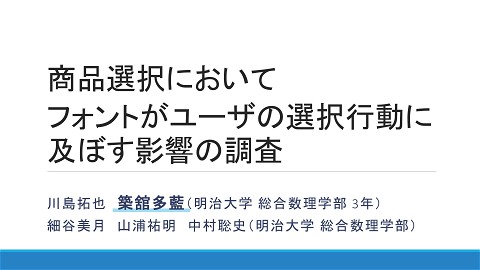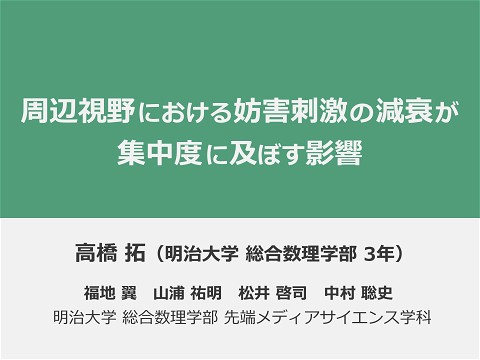The possibility of personality extraction using skeletal information in hip-hop dance by human or machine
598 Views
September 09, 19
スライド概要
INTERACT2019で発表した際のプレゼン用スライドです。
This slide is for the presentation when presented at INTERACT2019.
「The possibility of personality extraction using skeletal information in hip-hop dance by human or machine」
明治大学 総合数理学部 先端メディアサイエンス学科 中村聡史研究室
関連スライド
各ページのテキスト
The Possibility of Personality Extraction Using Skeletal Information in Hip-Hop Dance by Human or Machine Saeka Furuichi (Meiji University) Kazuki Abe, Satoshi Nakamura (Meiji University)
Dance Dance is very popular all over the world Breakdance Added as a new competition at 2018 Youth Olympics There has also been a huge demand for learning how to dance as well
How to improve dancing n To learn from skilled instructors Learners can practice choreographies that matches their level n To learn from dance videos on the Web …Popular with beginners and students because it can be easily challenged • Learner need to find appropriate choreographies themselves • Difficult to objectively identify whether the choreography suits them or not
System flow Target dancer who learning from dance videos Develop a system that can search for dance videos match their own personality For you! User 1. Dance in front of the camera 2. Upload dance videos to the system 4. System recommends videos with similar personalities System 3. Analyzes personality
Personality One of the key elements of dance Clear expression Unclear expression becomes more attractive tends to be superficial and boring It is important for dancers to develop their own personality In the previous breakdance example, personality is included as one of the judging criteria (Trivium Value System)
Related work Many dance studies using body motion data • Developed a method to make dance motions natural on VR by HMMs. [Mousas ‘18] • Classified dance motions related to emotions using LMA. [Aristidou ‘15] • Proposed a system for emotional behavior recognition. [Senecal ‘16] Few studies focused on dance personality The specific elements when the personality appears are not clear
Purpose The purpose of research To search for characteristic which can be personality from skeletal information in hip-hop dance Easy to obtain dance skeletons by using Kinect, OpenPose and so on 1. Can human distinguish personality? 2. Can machine distinguish personality?
Dataset Construction Skeletal information • Extracted from dance movement by Kinect • Composed of 15-points at 3D coordinates Participants • 22 university students (7 males, 15 females) • Let them dance the particular choreography five times
Dataset Construction Participants • Dance experience …Ranging from five months to six years (avg. 2.4 years) • Practice …Had 1-hour practice sessions twice a week for three weeks Particular choreography …Including many movements using the whole body such as raising the legs, squatting, turning, and hitting the chest Dataset: 22 participants × 5 times = 110 items (15 sec. × 110 items = 1650 sec.)
Dataset Construction Choreography used • Used from actually videos on the Web • Participants practiced in the club for school festival's performance • Music : Traila$ong’s “Gravity” Instructions • Asked participants to reproduce the choreography of the dance video • Asked participants to practice everyone together to make the same choreography
1. Can human distinguish personality? Let participants to select the dance that they thought their own one, and rank the skeletons from first to third place → To clarify whether it is possible to distinguish one’s own dance from video of only skeleton select the dance 5 times
1. Can human distinguish personality? • The selection of dance × 5 times • To rank the skeletons from first to third place • 1st=5 point, 2nd=3 point, 3rd=1 point The average point of each skeleton = “Score” 𝑃𝑜𝑖𝑛𝑡 1 + 𝑃𝑜𝑖𝑛𝑡 2 + ⋯ + 𝑃𝑜𝑖𝑛𝑡 4 + 𝑃𝑜𝑖𝑛𝑡(5) 𝑆𝑐𝑜𝑟𝑒 = 5
1. Can human distinguish personality? Let participants to select the dance that they thought their own one, and rank the skeletons from first to third place → To clarify whether it is possible to distinguish one’s own dance from video of only skeleton Interviewed for element to determine the distinction → To clarify where the personality appears in the skeleton
1. Can human distinguish personality? Divided participants into two groups Howthe much they of canexpressing express the personality manner personality differs depending theof level ofdance experience depends on theon level their experience 11 participants Dance experience Little experience 11 participants Rich experience
1. Can human distinguish personality? Divided participants into two groups 11 participants Dance experience 11 participants Little experience Rich experience ・Never learned from a skilled teacher ・Delightful dance as a hobby ・Learning from skilled instructors ・A lot of practice
1. Results The skeletal information that each participant thinks the answer Each participant A's B's C's D's E's F's G's H's I's J's K's L's A B C D E F G … K 2.8 0.0 0.0 1.2 0.2 0.0 2.0 … 0.0 1.2 3.6 0.6 1.0 0.8 0.6 0.0 … 0.2 0.0 0.2 0.8 0.0 2.2 0.0 0.2 … 0.0 0.6 0.0 1.2 0.6 1.0 0.2 0.0 0.8 0.6 0.2 1.8 0.2 2.0 0.8 0.0 0.0 0.0 0.2 0.0 0.4 2.0 A1.8 1.0 the 1.0 0.6 0.8 •0.0Participant chose 0.4answers 0.2 1.6 5 0.0times 3.2 0.0 0.2 0.0 1.2 2.6 the 1.6 score(average 0.0 1.2 0.0 0.4 point) 0.0 0.0 •0.0Add 2.2 1.2 3.2 0.0 1.2 0.4 0.2 0.0 0.0 to each skeletal information 0.6 1.0 0.0 2.4 0.4 0.6 0.0 1.8 0.0 … … … … … … … … … 0.0 0.6 2.8 0.0 3.4 0.0 1.0 0.0 1.0
1. Results The skeletal information that each participant thinks the answer Each participant A's B's C's D's E's F's G's H's I's J's K's L's A B C D E F G … K 2.8 0.0 0.0 1.2 0.2 0.0 2.0 … 0.0 1.2 0.0 0.6 0.0 1.2 0.6 1.0 0.2 0.0 3.6 0.2 0.2 1.8 0.2 2.0 0.8 0.0 0.0 0.6 0.8 0.0 0.0 0.4 2.0 1.8 1.0 1.0 0.0 0.4 0.2 0.0 3.2score 0.0 0.2 •1.0Highlight the1.6 highest 2.2 0.0 2.6 A1.6 0.0 1.2 •0.8Participant chose her 0.0 own0.4 0.6skeleton 0.0 2.2 1.2 3.2 final 0.0 1.2 0.4 0.2 as the answer 0.0 0.2 0.6 1.0 0.0 2.4 0.4 0.6 0.0 … … … … … … … … … 0.2 0.0 0.0 0.6 2.8 0.0 3.4 0.0 1.0 0.8 0.0 0.6 0.0 0.0 0.0 1.8 … 0.0 0.6 0.2 0.8 1.2 0.0 0.0 0.0 … 1.0
1. Results Little experience Rich experience 2 out of 11 participants gave the highest score 5 out of 11 participants gave the highest score a's b's c's d's e's f's g's h's i's j's k's l's a b c d e f g h i j k 0.4 0.0 0.0 0.2 0.0 0.0 0.2 0.0 0.0 0.2 0.0 3.0 0.6 0.6 0.6 0.0 0.0 0.0 0.2 0.0 0.6 1.0 0.6 0.0 2.4 1.2 0.2 0.0 0.0 0.6 0.0 0.0 0.6 0.0 0.0 0.6 0.6 0.0 0.6 0.0 0.0 0.2 1.2 0.0 0.0 1.6 1.0 1.0 1.4 0.0 0.0 0.0 0.0 0.8 0.0 0.0 0.6 0.0 0.2 0.2 0.8 3.2 0.0 0.0 0.0 2.2 1.2 0.4 2.0 0.0 0.0 1.6 0.6 0.2 1.6 0.0 2.2 1.8 0.0 1.0 1.0 3.2 0.4 0.0 2.6 0.0 2.2 0.2 0.2 0.8 0.4 1.2 0.6 0.6 0.2 0.0 4.6 0.0 2.0 0.0 0.0 0.2 1.2 0.4 0.2 0.2 0.2 0.2 0.0 0.0 1.2 4.2 0.8 1.0 2.0 2.8 2.4 1.2 2.4 2.2 0.8 0.6 0.8 0.0 0.8 1.0 2.0 2.2 4.0 0.0 1.8 0.0 A's B's C's D's E's F's G's H's I's J's K's L's A 2.8 B 0.0 C 0.0 D 1.2 E 0.2 F 0.0 G 2.0 H 0.0 I 0.2 J 0.0 K 0.0 1.2 3.6 0.6 1.0 0.8 0.6 0.0 0.2 1.2 0.6 0.2 0.0 0.2 0.8 0.0 2.2 0.0 0.2 0.0 0.8 0.2 0.0 0.6 0.2 0.0 0.4 0.0 2.2 0.6 0.6 0.6 0.0 0.0 0.0 1.8 0.0 0.2 2.6 1.2 1.0 0.4 0.0 2.0 0.6 1.2 0.2 0.4 1.6 1.6 3.2 0.0 0.2 0.6 1.0 2.8 0.6 2.0 2.0 0.0 0.0 0.0 2.4 0.0 1.0 1.0 0.0 1.0 0.8 1.8 3.2 1.2 1.2 0.4 2.6 2.6 0.8 3.4 0.2 0.0 1.0 0.0 0.0 0.4 0.6 0.0 0.0 0.6 0.0 0.0 0.0 1.0 0.2 0.4 0.2 0.0 0.0 1.6 0.6 1.0 0.8 0.0 0.6 0.0 0.0 0.0 1.8 4.2 0.2 2.2 0.0 0.6 0.2 0.8 1.2 0.0 0.0 0.0 0.8 0.2 0.0 1.0 In both groups, the participants who did not choose their own dance tended to choose the specific one
1. Results(interview) Little –avg. 2.3 cases ・Rich –avg. 3.2 cases nBody part used for discrimination Hands Little Rich Total Feet 10 17(11) 27 Chest 2 4 6 Whole body 1 2 3 Other 10 8 18 3 3 6 nElement used for discrimination Shape Movement Speed Little Rich Total 8(6) 20(10) 28 7 1 8 Timing 3 5 8 2 3 5 Habit 0 4 4 Direction Center of gravity 2 2 4 3 1 4
1. Results Percentage of participants who chose their own dance Noticed body part Noticed elements Little Rich 18% 45% (2/11) (5/11) Hand, Whole body Movement Shape
1. Results Percentage of participants who chose their own dance Noticed body part Noticed elements Little Rich 18% 45% (2/11) (5/11) Hand, Whole body Movement Shape Rich experience group were able to identify their own dance more accurately
1. Results Little Rich Percentage ofe.g., participants 45% movement 18% who chose their of own arms,dance knees (2/11) e.g., angle(5/11) of hands Noticed body part Hand, Whole body Noticed elements Movement Shape Rich experience group were able to identify their own dance more accurately Generate machine learning's features using these two elements of concentrated answers
2. Can machine distinguish personality? Classify the dance by generating feature quantities based on discrimination factors ‘ Used the 3D skeletal information obtained by Kinect nMovement -> Movement amount features Amount of spatial movement of each skeletal point every second nShape -> Joint angle features Average of joint angles every second (30 frames)
2. Can machine distinguish personality? • Divided participants into the same two groups as the subjective evaluation experiment Little experience Rich experience • Used Random Forest as the classification algorithm • Performed 12-value classification learning • To determine how well dancers can be identified from skeletal information
2. Generating feature quantities Movement features …Generated 13D vectors by calculating the amount of spatial movement elbow shoulder torso hand hip knee foot 182 𝑑𝑖𝑚𝑒𝑛𝑠𝑖𝑜𝑛𝑠 𝑜𝑓 14 𝑠𝑒𝑐𝑜𝑛𝑑𝑠 × 13 𝑑𝑖𝑚𝑒𝑛𝑠𝑖𝑜𝑛𝑠
2. Generating feature quantities Angle features …Generated 6D vectors by calculating the joint angles elbow shoulder knee
2. Generating feature quantities Angle features …Generated 6D vectors by calculating the joint angles 84 𝑑𝑖𝑚𝑒𝑛𝑠𝑖𝑜𝑛𝑠 = 14 sec× 6 𝑑𝑖𝑚𝑒𝑛𝑠𝑖𝑜𝑛𝑠 1sec (6D vector) name cnt 0 a 1 1 a 2 2 a 3 3 a 4 4 a 5 5 b 1 … … … elbow0L 0.405474 0.156565 0.675029 0.542914 0.355517 0.310615 … elbow0R 0.746739 0.919898 0.559499 0.537184 1.151986 0.636567 … shoulder0L shoulder0R 2.043996 1.654233 1.801457 1.539244 1.715216 2.000154 1.742386 1.649719 1.825681 1.625627 2.267780 1.821457 … … knee0L 0.473768 0.718211 0.446872 0.464316 0.632807 0.312968 … 14set (0-13) knee0R 0.724654 0.813780 0.599390 0.701625 0.653617 0.665087 … … … … … … … … … knee13R 0.905857 0.987754 1.044120 0.265405 0.758982 1.047929 …
2. Generating feature quantities As two countermeasures for noise 2D • Linear interpolation from the frame before and after the defect frame • Smoothing by the method of exponential moving average Before After
2. Can machine distinguish personality? Dance 1 Dance 2 Training data Dance 3 Dance 4 Dance 5 Test data 10 (= @𝐶A ) combinations of training and test data can be made from data per person • Learned 10 patterns each time • Calculated classification probability and average accuracy rate from the results
2. Results The classification probability A B C D E F G … L A's B's C's D's E's F's G's … L's 0.26 0.03 0.04 0.14 0.08 0.05 0.04 ... 0.03 ... ... ... ... ... ... ... … ... 0.03 0.06 0.08 0.03 0.02 0.03 0.15 ... 0.25 0.04 0.37 0.07 0.04 0.04 0.07 0.07 ... 0.08 0.04 0.07 0.32 0.05 0.04 0.05 0.09 … 0.10 0.14 0.04 0.04 0.24 0.09 0.05 0.04 ... 0.03 0.09 0.04 0.04 0.10 0.37 0.08 0.03 ... 0.03 0.05 0.07 0.05 0.05 0.08 0.34 0.05 ... 0.04 0.04 0.06 0.09 0.05 0.03 0.03 0.24 ... 0.16
2. Results The classification probability A's B's C's D's E's F's G's A B C D E F G … L 0.26 0.04 0.03 0.37 0.04 0.07 0.14 0.04 0.08Each 0.04 0.05 0.07 0.04 0.07 ... ... 0.03 0.08 … L's 0.04 0.14 0.09 0.05 0.04 ... 0.03 0.07 0.04 0.04 0.07 0.06 ... 0.06 0.32 0.04 0.04 0.05 0.09 ... 0.08 0.05 0.24 0.10 0.05 0.05 ... 0.03 0.04 0.09 0.37 0.03 ... 0.02 participant to0.08 be classified 0.05 0.05 0.08 0.34 0.03 ... 0.03 0.09 0.04 0.03 0.05 0.24 ... 0.15 … ... ... ... ... … ... 0.10 0.03 0.03 0.04 0.16 ... 0.25
2. Results The classification probability A's B's C's D's E's F's G's A B C D E F G … L … L's 0.26 0.04 0.04 0.14 0.09 0.05 0.04 ... 0.03 0.03 0.37 0.07 0.04 0.04 0.07 0.06 ... 0.06 Each of skeletal 0.04 0.07dance 0.32 0.04 0.04 0.05information 0.09 ... 0.08 0.14 0.04 0.05 0.24 0.10 0.05 0.05 ... 0.03 0.08 0.04 0.04 0.09 0.37 0.08 0.03 ... 0.02 0.05 0.07 0.05 0.05 0.08 0.34 0.03 ... 0.03 0.04 0.07 0.09 0.04 0.03 0.05 0.24 ... 0.15 ... ... … ... ... ... ... … ... 0.03 0.08 0.10 0.03 0.03 0.04 0.16 ... 0.25
2. Results The classification probability A's B's C's D's E's F's G's A B C D E F G … L 0.26 0.03 0.04 0.14 0.08 0.05 0.04 ... 0.03 0.04 0.37 0.07 0.04 0.04 0.07 0.07 ... 0.08 0.04 0.07 0.32 0.05 0.04 0.05 0.09 … 0.10 … L's 0.14 0.09 0.05 0.04 ... 0.03 0.04 0.04 0.07 0.06 ... 0.06 0.04 0.04 0.05 0.09 ... 0.08 0.24 0.10The 0.05total 0.05of... 0.03 the0.37 table 0.09 0.08row 0.03direction ... 0.02 normalized 0.05is0.08 0.34 0.03 as...1.00.03 0.04 0.03 0.05 0.24 ... 0.15 ... ... ... ... … ... 0.03 0.03 0.04 0.16 ... 0.25
2. Results The classification probability A's B's C's D's E's F's G's A B C D E F G … L 0.26 0.03 0.04 0.14 0.08 0.05 0.04 ... 0.03 … L's 0.04 0.04 0.14 0.09 0.05 0.04 ... 0.37 0.07 0.04 0.04 0.07 0.06 ... 0.07 0.32 0.04 0.04 0.05 0.09 ... Highlight the highest score 0.04 0.05 0.24 0.10 0.05 0.05 ... 0.04 0.04 0.09 0.37 0.08 0.03 ... 0.07 0.05 0.05 0.08 0.34 0.03 ... 0.07 0.09 0.04 0.03 0.05 0.24 ... ... … ... ... ... ... … 0.08 0.10 0.03 0.03 0.04 0.16 ... 0.03 0.06 0.08 0.03 0.02 0.03 0.15 ... 0.25
2. Results By movement features Little experience a b c d e f g h i j k l Rich experience a's b's c's d's e's f's g's h's i's j's k's l's A's B's C's D's E's F's G's H's I's J's K's L's 0.34 0.01 0.08 0.13 0.09 0.05 0.08 0.01 0.06 0.06 0.05 0.05 A 0.22 0.08 0.07 0.07 0.10 0.06 0.06 0.08 0.08 0.08 0.03 0.06 B 0.08 0.31 0.05 0.07 0.07 0.08 0.05 0.06 0.05 0.08 0.04 0.06 C 0.07 0.06 0.31 0.06 0.08 0.07 0.07 0.04 0.08 0.04 0.06 0.04 D 0.06 0.07 0.05 0.19 0.05 0.09 0.09 0.11 0.07 0.09 0.06 0.06 E 0.09 0.08 0.08 0.07 0.35 0.05 0.05 0.05 0.06 0.06 0.03 0.04 F 0.06 0.08 0.05 0.10 0.05 0.26 0.07 0.08 0.05 0.08 0.06 0.05 G 0.07 0.08 0.07 0.11 0.06 0.08 0.15 0.09 0.06 0.08 0.08 0.07 H 0.08 0.06 0.05 0.11 0.05 0.08 0.08 0.26 0.05 0.07 0.06 0.07 I 0.08 0.07 0.08 0.08 0.07 0.07 0.06 0.06 0.21 0.06 0.08 0.08 groups J 0.07 0.07 0.04 0.10 0.06 0.08 0.08 0.09 0.06 0.22 0.06 0.08 K 0.03 0.05 0.07 0.08 0.03 0.08 0.09 0.06 0.09 0.07 0.30 0.05 L 0.08 0.07 0.05 0.08 0.05 0.08 0.07 0.09 0.08 0.09 0.06 0.20 0.01 0.42 0.03 0.03 0.05 0.05 0.06 0.12 0.04 0.06 0.06 0.06 0.06 0.03 0.32 0.11 0.07 0.08 0.12 0.03 0.07 0.03 0.03 0.05 0.12 0.04 0.11 0.22 0.09 0.07 0.10 0.04 0.05 0.06 0.05 0.06 0.08 0.06 0.06 0.09 0.23 0.05 0.10 0.05 0.06 0.08 0.07 0.08 0.03 0.05 0.06 0.05 0.05 0.30 0.09 0.08 0.08 0.09 0.07 0.05 0.06 0.05 0.10 0.08 0.09 0.09 0.25 0.04 0.07 0.07 0.04 0.06 0.01 0.12 0.03 0.03 0.05 0.09 0.04 0.35 0.07 0.06 0.06 0.09 Both 0.05 0.05 0.07 0.06 0.07 0.10 0.09 0.07 0.24 0.11 0.05 0.06 0.05 0.07 0.03 0.06 0.07 0.09 0.08 0.06 0.10 0.26 0.08 0.05 Each participant’s own dance had the highest classification probability The average accuracy rate: Little: 95.4% /Rich: 89.5% 0.04 0.05 0.02 0.04 0.06 0.06 0.03 0.05 0.04 0.08 0.43 0.10 0.04 0.05 0.05 0.05 0.07 0.06 0.07 0.08 0.05 0.05 0.10 0.34
2. Results By angle features Little experience a b c d e f g h i j k l Rich experience a's b's c's d's e's f's g's h's i's j's k's l's A's B's C's D's E's F's G's H's I's J's K's L's 0.25 0.07 0.10 0.05 0.05 0.09 0.08 0.07 0.05 0.09 0.05 0.06 A 0.26 0.04 0.04 0.14 0.09 0.05 0.04 0.08 0.09 0.08 0.05 0.03 B 0.03 0.37 0.07 0.04 0.04 0.07 0.06 0.05 0.05 0.06 0.09 0.06 C 0.04 0.07 0.32 0.04 0.04 0.05 0.09 0.03 0.06 0.10 0.08 0.08 D 0.14 0.04 0.05 0.24 0.10 0.05 0.05 0.08 0.10 0.08 0.05 0.03 E 0.08 0.04 0.04 0.09 0.37 0.08 0.03 0.07 0.08 0.07 0.04 0.02 F 0.05 0.07 0.05 0.05 0.08 0.34 0.03 0.05 0.08 0.09 0.09 0.03 G 0.04 0.07 0.09 0.04 0.03 0.05 0.24 0.06 0.06 0.09 0.09 0.15 H 0.09 0.07 0.03 0.09 0.08 0.06 0.05 0.26 0.10 0.08 0.06 0.03 I 0.08 0.05 0.06 0.09 0.08 0.07 0.05 0.11 0.18 0.10 0.08 0.05 groups J 0.08 0.05 0.08 0.07 0.07 0.08 0.07 0.07 0.09 0.20 0.08 0.06 K 0.05 0.09 0.08 0.04 0.04 0.08 0.07 0.06 0.08 0.09 0.25 0.08 L 0.03 0.08 0.10 0.03 0.03 0.04 0.16 0.05 0.06 0.08 0.10 0.25 0.05 0.40 0.06 0.04 0.07 0.07 0.06 0.07 0.02 0.06 0.04 0.06 0.08 0.07 0.27 0.03 0.04 0.08 0.07 0.07 0.06 0.09 0.06 0.07 0.06 0.06 0.04 0.31 0.08 0.06 0.08 0.08 0.07 0.06 0.06 0.03 0.05 0.08 0.04 0.07 0.26 0.08 0.09 0.06 0.05 0.08 0.09 0.05 0.07 0.06 0.06 0.04 0.06 0.24 0.09 0.10 0.04 0.09 0.08 0.06 0.06 0.06 0.05 0.06 0.08 0.09 0.30 0.07 0.05 0.07 0.07 0.07 0.05 0.07 0.06 0.05 0.05 0.10 0.07 0.26 0.06 0.08 0.08 0.09 Both 0.05 0.03 0.07 0.07 0.05 0.07 0.07 0.07 0.28 0.11 0.09 0.04 0.06 0.05 0.08 0.04 0.06 0.09 0.06 0.09 0.07 0.26 0.08 0.06 Each participant’s own dance had the highest classification probability The average accuracy rate: Little: 99.1% /Rich: 92.0% 0.03 0.03 0.05 0.04 0.07 0.08 0.06 0.07 0.05 0.07 0.38 0.06 0.04 0.06 0.06 0.02 0.05 0.05 0.07 0.10 0.03 0.07 0.08 0.36
2. Results The average classification accuracy Little Rich Movement feature 95.4% 89.5% Angle feature 99.1% 92.0% Machine learning can distinguish individuals
2. The reason rich experience group was worse • Compared to the little experience group, the rich experience group included more data with missing values • The dance that was wrongly estimated was concentrated on the data had missing values
2. Correctly estimated number In the rich group Except for BCEF where all dances were correct for both features Movement features 1 2 3 4 5 A 4 4 3 4 2 D 4 3 3 4 2 G 4 3 2 4 0 H 4 4 4 2 4 I 4 0 4 4 4 J 4 4 0 4 3 K 4 4 4 4 4 L 4 4 4 4 4 Angle features 1 2 3 4 5 A 1 4 4 4 4 D 4 4 1 4 4 G 4 4 4 4 3 H 4 4 4 4 4 I 4 0 4 1 4 J 3 4 4 4 4 K 4 4 3 4 4 L 3 4 4 2 4
2. Results When separated by a dance count instead of every second with features delimited every 4 counts (64 frames) Movement Angle Little 87% 94% Rich 72% 78% with features delimited every 2 counts (32 frames) Movement Angle Little 94% 99% Rich 87% 85%
2. Results(effective features) The random forest is ensemble learning that learns by a set of decision trees The importance of each feature vector can be evaluated by comparing each decision tree Result 1 Training Data Result 2 Result 3 Final Result
2. Results(effective features) n Movement features The upper body such as the chest and right shoulder etc. n Angle features The left and right knees
Discuss the personality nCan human distinguish personality? Human can find features subjectively from dances with only skeletal information →Many did not correctly identify their own dance nCan machine distinguish personality? Machine can discriminate dances with high accuracy regardless of the features used It should become easier to find the personality of one’s own dance by using these features
Where is the personality? Consider the position and elements of the body where personality tends to appear nCan human distinguish personality? Little Rich Hands Whole body Shape Movement 10 17 10 8 8 20 7 1 nCan machine distinguish personality? Movement Angle Considered to correspond to the whole body emphasized in the subjective evaluation, because the ratio occupied in the skeleton used for the subjective evaluation is large
To make this study Several challenges • Participants danced specific choreography → Necessary to conduct experiments with variety of choreography, and to clarify whether it is possible to identify the dancer
To make this study Several challenges • Participants danced specific choreography → Necessary to conduct experiments with variety of choreography, and to clarify whether it is possible to identify the dancer Future work • Clarify what constitutes personality in dance • Examine the application method of the extracted personality • Consider the method to search for dance videos that match the personality of the user
Conclusion Examined hip-hop dance to clarify the possibility to extract personality nCan human distinguish personality? • Human can distinguish the specific dance in the only skeletal information • The little group focused the movement • The rich group focused the shape nCan machine distinguish personality? • Machine can discriminate individuals with high accuracy using either of two features, movement amount and joint angle





